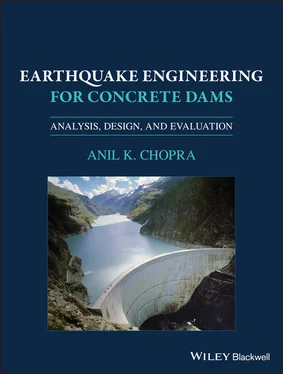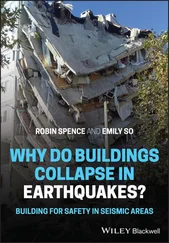Anil K. Chopra - Earthquake Engineering for Concrete Dams
Здесь есть возможность читать онлайн «Anil K. Chopra - Earthquake Engineering for Concrete Dams» — ознакомительный отрывок электронной книги совершенно бесплатно, а после прочтения отрывка купить полную версию. В некоторых случаях можно слушать аудио, скачать через торрент в формате fb2 и присутствует краткое содержание. Жанр: unrecognised, на английском языке. Описание произведения, (предисловие) а так же отзывы посетителей доступны на портале библиотеки ЛибКат.
- Название:Earthquake Engineering for Concrete Dams
- Автор:
- Жанр:
- Год:неизвестен
- ISBN:нет данных
- Рейтинг книги:4 / 5. Голосов: 1
-
Избранное:Добавить в избранное
- Отзывы:
-
Ваша оценка:
Earthquake Engineering for Concrete Dams: краткое содержание, описание и аннотация
Предлагаем к чтению аннотацию, описание, краткое содержание или предисловие (зависит от того, что написал сам автор книги «Earthquake Engineering for Concrete Dams»). Если вы не нашли необходимую информацию о книге — напишите в комментариях, мы постараемся отыскать её.
offers a comprehensive, integrated view of this progress over the last fifty years. The book offers an understanding of the limitations of the various methods of dynamic analysis used in practice and develops modern methods that overcome these limitations.
This important book:
Develops procedures for dynamic analysis of two-dimensional and three-dimensional models of concrete dams Identifies system parameters that influence their response Demonstrates the effects of dam–water–foundation interaction on earthquake response Identifies factors that must be included in earthquake analysis of concrete dams Examines design earthquakes as defined by various regulatory bodies and organizations Presents modern methods for establishing design spectra and selecting ground motions Illustrates application of dynamic analysis procedures to the design of new dams and safety evaluation of existing dams. Written for graduate students, researchers, and professional engineers,
offers a comprehensive view of the current procedures and methods for seismic analysis, design, and safety evaluation of concrete dams.



 ; ω 1, and ζ 1are the fundamental natural frequency and the viscous damping ratio of the dam alone;
; ω 1, and ζ 1are the fundamental natural frequency and the viscous damping ratio of the dam alone;


 , where ω is the exciting frequency, the modal coordinate can be expressed in terms of its complex‐valued frequency response function,
, where ω is the exciting frequency, the modal coordinate can be expressed in terms of its complex‐valued frequency response function,  . Upon substitution into Eq. (2.2.2)and canceling e iωton both sides gives
. Upon substitution into Eq. (2.2.2)and canceling e iωton both sides gives
 due to arbitrary ground acceleration in the x ‐direction can be computed from dam response to harmonic ground motion, characterized by the frequency response function ( Eq. (2.2.7)), using standard Fourier synthesis techniques. Alternatively, it can be expressed in terms of D 1( t ), the deformation response of the first‐mode single‐degree‐of‐freedom (SDF) system, an SDF system with vibration properties – natural frequency ω 1and damping ratio ζ 1– of the first vibration mode of the dam. The equation of motion of this SDF system subjected to ground acceleration
due to arbitrary ground acceleration in the x ‐direction can be computed from dam response to harmonic ground motion, characterized by the frequency response function ( Eq. (2.2.7)), using standard Fourier synthesis techniques. Alternatively, it can be expressed in terms of D 1( t ), the deformation response of the first‐mode single‐degree‐of‐freedom (SDF) system, an SDF system with vibration properties – natural frequency ω 1and damping ratio ζ 1– of the first vibration mode of the dam. The equation of motion of this SDF system subjected to ground acceleration  is given by
is given by
 ,
,  , and
, and  . Comparing Eq. (2.2.5)to Eq. (2.2.8)gives the relation between q 1and D 1:
. Comparing Eq. (2.2.5)to Eq. (2.2.8)gives the relation between q 1and D 1:



 is the ordinate of the deformation response (or design) spectrum for the x‐ component of ground motion evaluated at period T 1= 2 π / ω 1, and damping ratio ζ 1; the subscript “ o ” that denotes peak value will subsequently be dropped to simplify notation.
is the ordinate of the deformation response (or design) spectrum for the x‐ component of ground motion evaluated at period T 1= 2 π / ω 1, and damping ratio ζ 1; the subscript “ o ” that denotes peak value will subsequently be dropped to simplify notation.
 is the ordinate of the pseudo‐acceleration response (or design) spectrum, and w k( x , y ) = g m k( x , y ). Because the vertical ( k = y ) component of displacements in the fundamental vibration mode,
is the ordinate of the pseudo‐acceleration response (or design) spectrum, and w k( x , y ) = g m k( x , y ). Because the vertical ( k = y ) component of displacements in the fundamental vibration mode,  , is much smaller than their horizontal ( k = x ) component, the associated vertical forces may be dropped, leaving only the horizontal ( k = x ) component of forces in Eq. (2.2.13):
, is much smaller than their horizontal ( k = x ) component, the associated vertical forces may be dropped, leaving only the horizontal ( k = x ) component of forces in Eq. (2.2.13):










